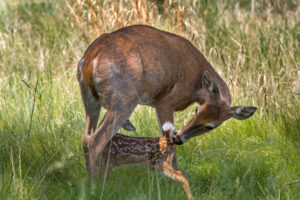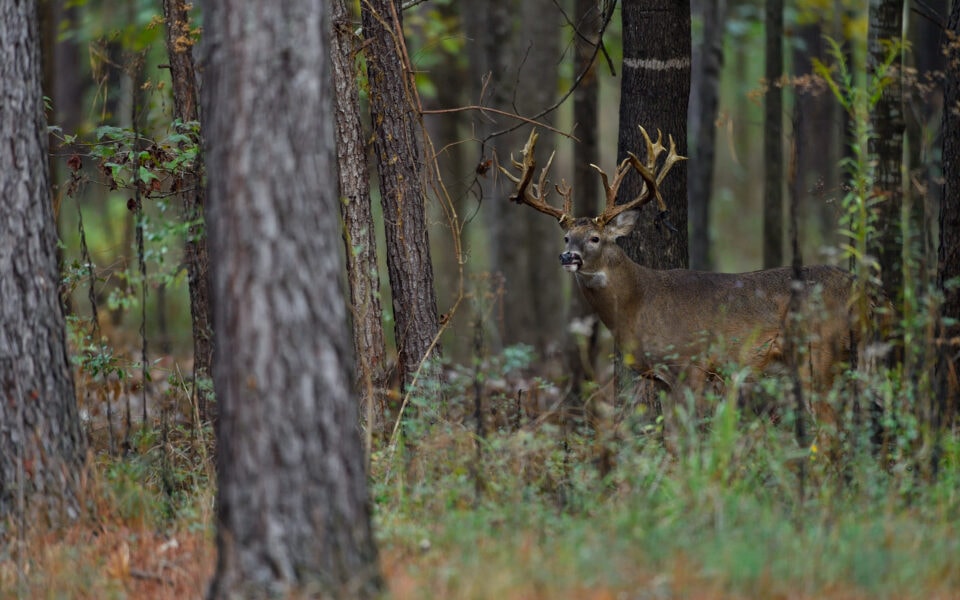Gamekeepers of wild whitetail herds cannot manage genetics through harvest to produce any measurable change in them. This is just a fact. While genetics play a big role in the antler development of an individual buck, as a gamekeeper there is little we can do to influence our wild herds. While most of us wish to harvest the biggest buck on our property during hunting season, the best thing we could do for the area’s antler size is to let the biggest bucks live so they can continue to breed.
Unless we could somehow control exactly which doe breeds with a specific buck, there is no way to impact genetics on a noticeable level. Remember that even if the giant you passed on breeds with a doe, you have no idea what genetic potential she is passing on, and she’s 50% of the recipe. Basically every study completed shows that it is impossible to impact antler size by culling certain bucks. However, there IS evidence to show that other things we can do will help individual bucks to reach their particular genetic potential.
The Genetic Truth about Whitetail Antlers

Not all deer have the same genetic potential
Antler development is genetically established so not all deer have the same potential. However, antler size can be greatly influenced by nutrition and other factors like stress. Both genetics and nutrition are important, and good nutrition can somewhat “mask” inferior genetics, but it can’t substitute for the genetic effect. It has been said, “It is possible to starve the antlers off of a buck with great genetics, but it is not possible to feed big antlers onto a deer which does not have the genetic capabilities to grow them.”
Antler points of yearling bucks show no connection to what they are able to produce later in life.
There are a few studies that show that the majority of yearling spike-bucks will produce fewer points later in life than multi-tined yearlings, however; a buck’s skeletal system must be finished developing before true genetic potential can be realized. Most studies show that spiked yearlings are just as likely to produce large antlers later in life as yearlings with multiple tines.
Does produce half of the genetic potential

Kerry Hargrove
In the wild, it’s difficult to impossible to keep track of what type of antlers a doe’s male offspring will produce, and does provide half of the genetic potential for antler development.
Nutrition can significantly impact antler growth.
Things like a drought, which might bring with it a huge negative fluctuation in native vegetation nutrition levels, the development of a food plot in a new area, or providing supplemental feed during the winter months, can all have a noticeable impact on antler size.
Antler development improves with age
Antler development continues to improve with age up until bucks are about 6 to 8 years old. Fluctuations in an area’s nutrition and some other outside factors might influence a buck’s largest set of antlers to be grown at a bit younger or older age, but those years should be the prime of an adult buck’s life.
Not just large antlers influence breeding
You can do little to improve antler genetics in the wild except to leave obviously superior bucks in the herd. However, while the older, more dominant bucks typically do the majority of the breeding, this is not a given. You may have aggressive bucks with small antlers or even spike bucks that breed some does. It is thought by many that body size has as big of an influence on which bucks will breed as does antler size.
We can make a Difference?
In my view, whitetails really don’t have a “genetic problem” that we need to fix, but some still try to manage herds like there is. However, bucks do have many actual problems of other kinds that affect antler growth that we can do something about. You’ve seen above that nutrition was mentioned several times, but this is the one area where we can have the biggest influence.
Another reason bucks produce inferior antlers is because they were born late, most often because of skewed sex ratios. When this happens they get a delayed start on their physical development from the very beginning.
These things we CAN do to help antler growth
Improve available nutrition
Bolster and improve nutrition on a year-round basis through food plots and native habitat improvements.
Let bucks reach maturity
Obviously we need to protect immature bucks to give them a chance to reach maturity so they can show their true genetic potential.
Herd management
Balance adult sex ratios through harvesting does. Often fawns are born late because there aren’t enough bucks to breed all the does during their first estrus cycle, so does conceive later, meaning fawns are also born latter. We also want to make sure we balance the area’s density to the habitat. More mouths mean less quality food for the rest of the herd. Too many deer also creates social stress which also has a negative impact on antler size.
The deduction is, genetics mean a lot to each individual buck’s outcome relating to antler characteristics and body size, but there is nothing we can do to CONTROL them in the wild. We can only change them, or give them a gentle nudge by harvesting some deer and letting others live.










